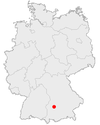Augsburg
|
|
| Coat of arms | Map |
|---|---|
| Statistics | |
| State: | Bavaria |
| Regierungsbezirk: | Swabia |
| District: | Independent city |
| Area: | 146.78 km² |
| Population: | 275,912 (May 2004) |
| Population density: | 1,880/km² |
| Elevation: | 489 m |
| Postal code: | 86000-86199 (old: 8900) |
| Area/distance code: | 0821 |
| Location: | Template:Coor dm |
| Municipal code: | 0976100 |
| Car designation: | A
|
| Arrangement of the city: | 17 Districts |
| Address of the city administration: | Maximilianstraße 5 86150 Augsburg |
| Website: | www.augsburg.de |
Augsburg is a city in south central Germany. It is the capital of the Swabia (Schwaben) region of Bavaria (Bayern), and is located at the confluence of the Wertach and Lech rivers. Population: 276,193 (2004).
| Contents |
Districts
There are 17 districts Stadteile in Augsburg:
- Innenstadt
- Antonsviertel
- Bärenkeller
- Bergheim (includes Neubergheim, Wellenburg, Radegundis and Fuchssiedlung)
- Firnhaberau
- Göggingen mit Schafweidsiedlung
- Hammerschmiede
- Haunstetten-Siebenbrunn (Meringerau)
- Herrenbach-Spickel
- Hochfeld
- Hochzoll
- Inningen
- Kriegshaber
- Lechhausen
- Oberhausen
- Pfersee
- Universitätsviertel
History
The city was founded in 15 BC in the reign of Roman emperor Augustus as a garrison called Augusta Vindelicorum.
It became an Imperial Free City on March 9, 1276. Given its strategic location on the trade routes to Italy, it became a major trading centre. It produced large quantities of woven goods, cloth and textiles, and was the base for the Fugger banking empire. The Fuggerei, part of the city devoted to housing for the needy citizens of Augsburg, was founded in 1516 and is still in use today.
In 1530 the Augsburg confession was presented to the Holy Roman Emperor at the Diet of Augsburg. In 1805, when the Holy Roman Empire was dissolved, Augsburg lost its independence and became part of the kingdom of Bavaria.
In 1941 Rudolf Hess took off from a local airport and flew to Scotland to meet the Duke of Hamilton and attempt to mediate the end of the European front of World War 2 and join sides for the upcoming Russian Campaign.
In 1945 elements of the US Army liberated the heavily damaged city. An American Military presence in the city started with the 11th Airborne division, moving to the 24th Infantry Division, US Army Seventh Corps Artillery, and, ending with the 66th Military Intelligence Brigade, which left the area in 1998
Incorporations
| Year | Municipality | Area |
|---|---|---|
| July 1, 1910 | Meringerau | 9.5 km² |
| January 1, 1911 | Pfarsee | 3.5 km² |
| January 1, 1911 | Oberhausen | 8.6 km² |
| January 1, 1913 | Lechhausen | 27.9 km² |
| January 1, 1913 | Hochzoll | 4.4 km² |
| April 1, 1916 | Kriegshaber | 59,000 m² |
| July 1, 1972 | Göggingen | |
| July 1, 1972 | Haunstetten | |
| July 1, 1972 | Inningen |
Historical population development:
| Year | Population |
|---|---|
| 1635 | 16,432 |
| 1645 | 19,960 |
| 1806 | 26,200 |
| 1830 | 29,019 |
| December 1, 1871 ¹ | 51,220 |
| December 1, 1890 ¹ | 75,629 |
| December 1, 1900 ¹ | 89,109 |
| December 1, 1910 ¹ | 102,487 |
| June 16, 1925 ¹ | 165,522 |
| June 16, 1933 ¹ | 176,575 |
| May 17, 1939 ¹ | 185,369 |
| September 13, 1950 ¹ | 185,183 |
| June 6, 1961 ¹ | 208,659 |
| May 27, 1970 ¹ | 211,566 |
| June 30, 1975 | 252,000 |
| June 30, 1980 | 246,600 |
| June 30, 1985 | 244,200 |
| May 27, 1987 ¹ | 242,819 |
| June 30, 1997 | 257,300 |
| December 31, 2002 | 259,231 |
¹ Census result
Partner Cities
- Inverness, Scotland, since 1956
- Amagasaki, Japan, since 1959
- Nagahama, Japan, since 1959
- Bourges, France, since 1963
- Dayton, Ohio, since 1964
- Liberec, Czech Republic, since 2001
Sights
- Town hall, built in 1620 in Renaissance style
- Perlachturm, a bell tower built in 1182
- Fuggerei, see above
- Bishop's residence, built about 1750 in order to replace the older bishop palace; today the administrative seat of Swabia
- Cathedral, founded in the 9th century
- Augsburger Puppenkiste
- Eiskanal
- Dorint Hotel Tower
Education
Augsburg is home to the following universities and colleges
Miscellaneous
The patron saint of Augsburg is Saint Afra, who was killed by the Romans at Augsburg in 304. An earlier patroness was Zisa, referenced in the 11th century, feast day September 28th), possibly an early Germanic goddess and originally the consort of Tiwaz.
The White Water Canoeing events for the 1972 Summer Olympics were held on the Lech in Augsburg.
See also : biodiesel, League of Augsburg
On the other hand, the city is home to heavy industry company MAN.
The Augsburg University was founded in 1970.
Notable citizens
- Paulus Hector Mair, 16th century martial artist.
- Jakob Fugger Noted banker and financial broker (1459-1525). Area within the city, called the Fuggerei was set aside for the poor and needy. Founded in 1519.
See also
- Augsburg College A private Lutheran College in the United States that takes its name from the City of Augsburg.
External links
- Stadt Augsburg (http://www.augsburg.de/Seiten/augsburg_e/index_e/index_e.shtml) Official site (English version)
- Augsburg Region Tourism (http://www.regio-augsburg.de/)
Sites in German:
- Augsburg City Plan (http://www.stadtplan.net/brd/bayern/augsburg/home.html)
- District of Augsburg (http://www.landkreis-augsburg.de/)
de:Augsburg es:Augsburgo eo:Augsburg fr:Augsbourg gl:Augsburgo it:Augusta (Germania) la:Augusta Vindelicorum lt:Augsburgas nl:Augsburg ja:アウクスブルク no:Augsburg pl:Augsburg sv:Augsburg


